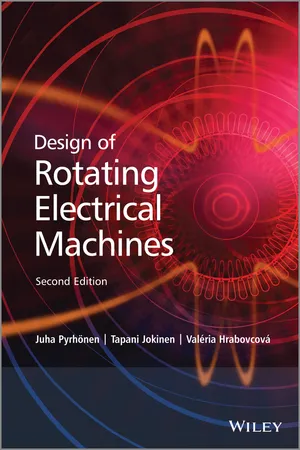
- English
- ePUB (mobile friendly)
- Available on iOS & Android
Design of Rotating Electrical Machines
About this book
In one complete volume, this essential reference presents an in-depth overview of the theoretical principles and techniques of electrical machine design. This timely new edition offers up-to-date theory and guidelines for the design of electrical machines, taking into account recent advances in permanent magnet machines as well as synchronous reluctance machines.
New coverage includes:
- Brand new material on the ecological impact of the motors, covering the eco-design principles of rotating electrical machines
- An expanded section on the design of permanent magnet synchronous machines, now reporting on the design of tooth-coil, high-torque permanent magnet machines and their properties
- Large updates and new material on synchronous reluctance machines, air-gap inductance, losses in and resistivity of permanent magnets (PM), operating point of loaded PM circuit, PM machine design, and minimizing the losses in electrical machines>
- End-of-chapter exercises and new direct design examples with methods and solutions to real design problems>
- A supplementary website hosts two machine design examples created with MATHCAD: rotor surface magnet permanent magnet machine and squirrel cage induction machine calculations. Also a MATLAB code for optimizing the design of an induction motor is provided
Outlining a step-by-step sequence of machine design, this book enables electrical machine designers to design rotating electrical machines. With a thorough treatment of all existing and emerging technologies in the field, it is a useful manual for professionals working in the diagnosis of electrical machines and drives. A rigorous introduction to the theoretical principles and techniques makes the book invaluable to senior electrical engineering students, postgraduates, researchers and university lecturers involved in electrical drives technology and electromechanical energy conversion.
Frequently asked questions
- Essential is ideal for learners and professionals who enjoy exploring a wide range of subjects. Access the Essential Library with 800,000+ trusted titles and best-sellers across business, personal growth, and the humanities. Includes unlimited reading time and Standard Read Aloud voice.
- Complete: Perfect for advanced learners and researchers needing full, unrestricted access. Unlock 1.4M+ books across hundreds of subjects, including academic and specialized titles. The Complete Plan also includes advanced features like Premium Read Aloud and Research Assistant.
Please note we cannot support devices running on iOS 13 and Android 7 or earlier. Learn more about using the app.
Information
| Electric field strength | E | [V/m] |
| Magnetic field strength | H | [A/m] |
| Electric flux density | D | [C/m2] |
| Magnetic flux density | B | [Vs/m2], [T] |
| Current density | J | [A/m2] |
| Electric charge density, dQ/dV | ρ | [C/m3] |









Table of contents
- Cover Page
- Title Page
- Copyright Page
- Preface
- About the Authors
- Abbreviations and Symbols
- Chapter 1: Principal Laws and Methods in Electrical Machine Design
- Chapter 2: Windings of Electrical Machines
- Chapter 3: Design of Magnetic Circuits
- Chapter 4: Inductances
- Chapter 5: Resistances
- Chapter 6: Design Process of Rotating Electrical Machines
- Chapter 7: Properties of Rotating Electrical Machines
- Chapter 8: Insulation of Electrical Machines
- Chapter 9: Losses and Heat Transfer
- Appendix A: Properties of Magnetic Sheets
- Appendix B: Properties of Round Enameled Copper Wires
- Index
- Eula